Did you know that over 70% of U.S. higher education institutions use blended learning? This fact shows how big an impact blended learning has on education today. It combines traditional classroom learning with online learning. This mix changes how students learn and engage.
This article explores the history and evolution of blended learning. It covers key events that changed education. Knowing these changes helps teachers and schools use blended learning models well. As technology keeps improving, this approach is vital for the future of education and good learning results in all settings.
Key Takeaways
- The rise of blended learning reflects a shift in educational paradigms.
- Effective integration of online and offline learning enhances student engagement.
- Historical milestones have laid the groundwork for modern blended learning practices.
- Technological advancements continue to shape the evolution of blended learning.
- Understanding the history helps institutions design suitable learning models.
Introduction to Blended Learning
Blended learning is a new way of teaching that mixes traditional classroom learning with online learning. This approach gives students more freedom to learn at their own pace. It combines face-to-face classes with online activities for a richer learning experience.
In recent years, blended learning has become more popular worldwide. Thanks to technology, schools are changing to meet new learning needs. This method makes learning more fun and interactive by using both in-person and online tools.
Blended learning has many parts that make it special. It balances online and offline learning, uses teachers as guides, and includes various educational tools. These parts help students stay engaged and succeed in today’s world. For more details, check out this in-depth look at blended learning.
Blended learning is always changing with new technology. Schools are now using hybrid models that focus on what students need. As it grows, blended learning brings both challenges and chances for teachers to improve their teaching.
Early Foundations of Distance Education
The history of distance education goes back to the 19th century with correspondence courses. These courses changed education by letting students learn through the mail. Sir Isaac Pitman started this in the 1840s with lessons on mailed postcards. This method let students learn at their own speed.
Later, new technologies came along. Radio and television made learning more interactive and accessible from afar. This helped reach more people who couldn’t go to school in person.
Early distance education set the stage for today’s correspondence courses. It also helped shape blended learning. With more media available, education became a mix of in-person and online learning. This mix is what we see in education today.
History and Evolution of Blended Learning
The story of blended learning is a mix of tech advances and smart teaching methods. In the 1960s, mainframe computers started this journey with structured learning. By the 1980s, Learning Management Systems (LMS) made learning more interactive and flexible.
1998 was a big year with the switch to web-based learning. This made learning materials and resources more accessible. Teachers saw that combining classroom and digital tools made learning more engaging and effective.
Over time, blended education has seen key milestones:
- 1960s: Introduction of mainframe computer-based training.
- 1980s: Growth of Learning Management Systems (LMS).
- 1998: Emergence of web-based instruction.
- 2000s: Introduction of hybrid learning models.
- 2010s: Expansion of mobile learning technologies.
This timeline shows how education has adapted to new tech while keeping students engaged. Each step in blended learning’s evolution has built on the last, shaping today’s learning methods.
| Year | Development | Impact on Blended Learning |
|---|---|---|
| 1960s | Mainframe Computer-Based Training | Laid groundwork for digital learning resources. |
| 1980s | Learning Management Systems (LMS) | Facilitated organized course management and tracking. |
| 1998 | Web-Based Instruction | Enabled widespread access to educational content. |
| 2000s | Hybrid Learning Models | Integrated face-to-face with online learning. |
| 2010s | Mobile Learning Technologies | Allowed learning anytime, anywhere through devices. |
Technological Advancements in Education
In recent years, technology has changed education a lot. Tools and resources have made learning more engaging and effective. They adapt to what each student needs. Multimedia is key in making learning better.
Introduction of Multimedia and LMS
Multimedia includes videos, interactive simulations, and audio presentations. It helps teachers reach students in different ways, making learning stick better. This makes students more involved with their studies.
Learning Management Systems (LMS) have also changed things. They help schools manage courses, track student progress, and improve communication. This approach combines online and offline learning for a complete education.
Impact of the Internet on Blended Learning
The internet has changed education a lot, making blended learning better. Now, learners can use the internet to learn in new ways. Online learning platforms let students get materials whenever they want, making learning more personal.
Virtual learning spaces are now key in blended education. Students can join lessons and talk with others from anywhere. This is great for those who have a lot on their plate, as they can study at any time.
Learning how to use the internet is more important than ever. As online learning grows, teaching digital skills is crucial. Teachers are now focusing on this skill to help students keep up with new technology in school.
Modern Blended Learning Models

Modern blended learning models show how teachers use new tech and methods. They mix traditional teaching with online tools for a better learning space. With tech like AI and VR, these models make learning fun and fit different ways of learning.
Integration of Cutting-Edge Technologies
Today, we see many blended learning plans that use online tools to make learning better. Here are three main models:
| Model | Description | Benefits |
|---|---|---|
| Rotation Model | Students switch between online and in-person learning. | Flexible schedules, personalized pace, and targeted feedback. |
| Flex Model | Online learning is the main part, with teachers helping when needed. | High levels of personalization and adaptability to individual student needs. |
| Enriched Virtual Model | Most learning is online, but students meet in person sometimes. | Combines self-directed learning with meaningful personal interaction. |
These modern blended learning models show how important it is to use new tech in schools. By using these plans, teachers can make learning fit each student’s needs. This helps students do well in school and get ready for a digital future.
The Role of the Global Pandemic in Accelerating Blended Learning
The COVID-19 crisis changed education worldwide. Schools moved online, showing the need for quick changes. Teachers started using emergency remote teaching, leading to a big push in accelerated digital learning.
This quick change showed the good and bad of blended learning. Teachers had to deal with training, tech issues, and keeping students interested in online classes. But, they found new ways to work together and be creative.
Looking back, schools learned a lot from this time. They saw the value of adding online parts to their classes. These new ways of teaching will likely stay in education.
- Challenges in digital access: Many students struggled to access the necessary technology.
- Need for training: Teachers required additional support in using new digital tools.
- Rise of hybrid models: Blended learning emerged as a viable long-term solution.
The global pandemic sped up the adoption of blended learning in schools. This change is expected to make lasting impacts on education.
Benefits and Challenges of Blended Learning

Blended learning has many benefits. It lets students learn at their own pace. It makes learning materials available for different learning styles. Teachers can make learning personal for each student, which helps students stay interested.
But, there are still challenges. Some schools don’t have the right technology for blended learning. Not all students have good internet or devices at home. Teachers need training to use blended learning well.
Resistance to change is another issue. Some teachers like traditional teaching and worry about the changes blended learning brings. We need to support teachers and plan carefully to help them use this new way of learning.
| Benefits | Challenges |
|---|---|
| Increased flexibility | Technological infrastructure deficits |
| Improved accessibility | Need for professional development |
| Personalized learning experiences | Resistance to change |
| Enhanced student engagement | Potential inequities in access |
Conclusion
The journey of blended learning has shown big steps forward in education. These steps make learning better and meet the needs of all learners in today’s changing world. With more technology, teachers can make learning flexible and personal for everyone.
Groups like Hyperspace are helping teachers use the latest learning methods. They offer important tools and help for a smooth move to blended learning. This approach improves how well students do in school.
But, making this change work well needs careful planning. We must think about how to get everyone on board and make sure the content fits the learning goals.
The future of blended learning looks promising, full of new ideas and growth. We need to focus on building strong support systems and making digital tools available to everyone. For more tips on blending learning well, check out what Hyperspace suggests.
FAQ
What is blended learning?
Blended learning mixes traditional classroom teaching with online parts. It makes learning better by giving students more flexibility and personal choices.
How has blended learning evolved over time?
Blended learning started with early distance learning in the 19th century. It grew with tech like multimedia and Learning Management Systems, changing how we learn today.
What are some common models of blended learning?
There are several blended learning models, like rotation, flex, and enriched virtual. These models mix online and offline learning to give students personalized learning.
What role does technology play in blended learning?
Technology is key in blended learning. It helps combine digital tools, supports online classes, and tracks student progress. New tech like AI and VR is making learning even better.
What benefits does blended learning offer in education?
Blended learning has many perks. It makes learning materials more accessible, offers flexible course delivery, and lets students learn in ways that fit their needs.
What challenges do educators face when implementing blended learning models?
Educators face issues like lacking tech, needing training, and resistance to change. Good planning and support help overcome these challenges.
How has the COVID-19 pandemic influenced blended learning practices?
The pandemic sped up blended learning’s growth. Teachers had to quickly use digital tools and strategies, improving online learning faster than before.
What is the future of blended learning in education?
Blended learning’s future looks bright, with new tech and teaching methods promising better learning environments. Groups like Hyperspace are helping teachers in this changing field.





